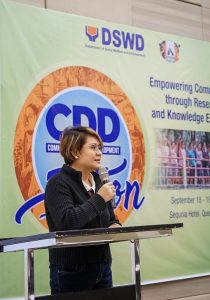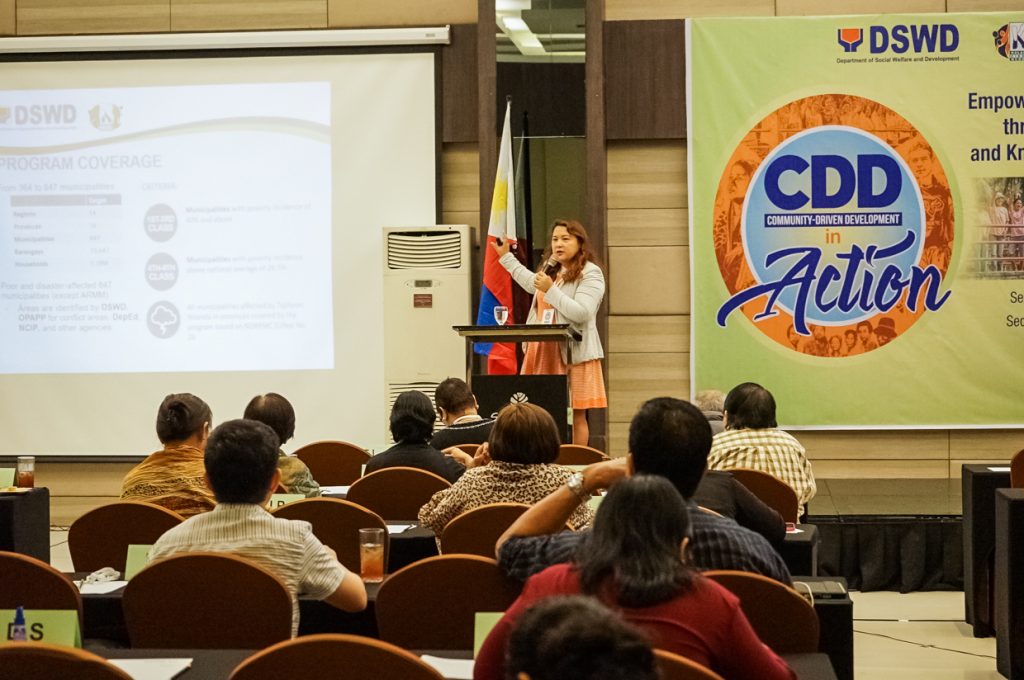MANILA, Philippines — The Department of Social Welfare and Development (DSWD) through its community empowerment program, Kapit-bisig Laban sa Kahirapan Comprehensive and Integrated Delivery of Social Services – National Community-Driven Development Program (Kalahi-CIDSS NCDDP), holds a Learning Event and Knowledge Management Forum, Sequoia Hotel, Quezon City, Manila, September 18-19, 2018.

The learning event dubbed as CDD (Community-Driven Development) in Action: Empowering Communities through Research and Knowledge Exchange is facilitated by the Kalahi-CIDSS Monitoring and Evaluation Unit (M&E) headed by Deputy National M&E Specialist Abigail de la Cruz.
DSWD Undersecretary Maria Lourdes T. Jarabe emphasized the importance of data and researches for program implementation and how this would help streamline the Kalahi-CIDSS successor program. This, as the Kalahi-CIDSS is in its closing phase in 2019. Undersecretary Jarabe also said that with researches conducted for the program – its results can help address the gaps in the program implementation. Undersecretary Jarabe also acts as the Deputy National Program Director and OIC for Kalahi-CIDSS NCDDP.
CDD in Action showcased national and regional studies conducted on Kalahi-CIDSS, and gathered comments and feedback from the program’s partners and stakeholders on these studies, mainly on ways to promote CDD and determining the challenging areas of the program.
The plenary sessions provided an avenue for the participants to organize a community of practice for continuous and regular exchange of information on community-driven development.
Alongside with the implementation of Kalahi-CIDSS since 2003, various studies were also conducted to assess program effectiveness at different levels through qualitative and/or quantitative approaches. Some interesting facts generated through these researches include: Kalahi-CIDSS was projected to generate a conservatively estimated economic internal rate of return of 21 percent and a net present value of P1.03 billion. (Measuring the Costs and Benefits of Community Driven Development: The
KALAHI-CIDSS Project, 2007)
It was also found out that Kalahi-CIDSS is an effective platform for integrating key elements of an effective local poverty reduction strategy. It provides citizens an experience in project management that gave them voice, held leaders accountable and able to demand transparency. (The KALAHI-CIDSS Project in the Philippines: Sharing Knowledge on Community-Driven Development, 2012)
Roads and water systems were the projects most desired by households and barangay officials. Barangay assembly attendance was reportedly high, with 68% of households indicating having a member attend in the past 6 months. (Impact evaluation of the Kalahi-CIDSS: Baseline Report, 2014)

Volunteers have become more confident, had leadership opportunities, acquired construction skills, and had found employment as staff in the barangay or in Kalahi-CIDSS. (Process Evaluation of Kalahi-CIDSS 2015)
In a case study conducted in July 2016, it was notably observed that there was a fast-paced organizing done by the community people. As the time of data collection, all (28), except two barangays had established women’s organizations in less than a year. Some organizations were reactivated (Kalahi-CIDSS NCDDP Process Documentation: Assessing Philippines’ Community-Driven Development Fast Tracked Response to Natural Disasters, 2016)
Kalahi-CIDSS National Communication Specialist Ma Rosario Consuelo Lagman presented Knowledge Products and endeavors which are produced by the different social marketing officers of DSWD regional field offices.
“What the studies tell us is that the poor, especially the marginalized such as the indigenous peoples and people living in conflict-affected areas, can truly benefit from the community-driven development approach. The results prove that giving communities control over decisions and resources makes people-centered development possible even in the most challenging contexts”, Lagman says.
She also said “the feedback given by the government agencies, representatives from the academe, and civil society organizations that now comprise DSWD Kalahi-CIDSS’ newly-formed Community of Practice will also help us address the challenges and strengthen the program implementation”.

This event highlights the different Kalahi-CIDSS national studies: TECHNICAL ASSESSMENT AND ECONOMIC ANALYSIS FOR THE KC-NCDDP PHILIPPINES (World Bank 2016) by Maria Loreto Padua, Social Development Specialist – World Bank; ENHANCING COMMUNITY-DRIVEN DEVELOPMENT THROUGH CONVERGENCE: A Case Study of Household and Community-Based Initiative in the Philippine Villages (ADB 2015).
CDD in Action also featured three regional studies by Todd Lucero, Rodolfo Nillosguin Jr, Christine June Arapoc, regional monitoring and evaluation specialist of DSWD Field Offices 7, 9, and 12 respectively.
Undersecretary Maria Lourdes T. Jarabe, in her closing message, highlighted the value of convergence, as evidenced by the national and regional studies presented in the forum. Policy reform agenda is a step closer when partners in development continue to do research and share what they know on CDD.
These studies add to the knowledge base of community-driven development. The good practices and lessons learned by the implementers serve as benchmark for other communities yet to adopt the participatory approached in lifting households out of poverty by providing them access to basic social services. More than their official publication, these good practices and lessons are meant to be shared to partners and stakeholders to inform program evaluation and policy reform agenda, through a learning event and knowledge management forum.
DSWD Kalahi-CIDSS in Region 10 covers 45 municipalities in the Provinces of Bukidnon, Lanao del Norte, Misamis Occidental, and Misamis Oriental with a total of 1,105 barangays funded since 2015, amounting to Php 992,386,007.41. This covers Cycles 1 through 3 of the implementation, with a total of 112,279 community volunteers involved in the sub-project implementations.
The 1105 community sub-projects include roads, water systems, health stations, flood control structures, electrification, school buildings, pre/post-harvest facilities, foot paths, sea walls, training centers, public markets, and spillways among others. Topping the list of community sub-projects are roads with 599 and water systems with 92.
The DSWD Kalahi-CIDSS and its community volunteers are advocating for Community-Driven Development institutionalization in the local governments for the continuation and sustainability of its gains and empowered communities.


